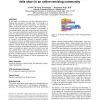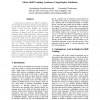97 search results - page 5 / 20 » Agency Attribution in Human-Computer Interaction |
HAPTICS
2009
IEEE
14 years 1 months ago
2009
IEEE
Human vibrotactile detection experiments were used to compare temporal sinusoids displayed on three commercial haptic devices to a high-Ô¨Ādelity linear voice-coil actuator. The t...
CHI
2011
ACM
12 years 10 months ago
2011
ACM
In this paper, we explore the role that attribution plays in shaping user reactions to content reuse, or remixing, in a large user-generated content community. We present two stud...
HRI
2006
ACM
14 years 29 days ago
2006
ACM
Humanoid robots offer many physical design choices such as voice frequency and head dimensions. We used hierarchical statistical mediation analysis to trace differences in people‚...
HAPTICS
2005
IEEE
14 years 18 days ago
2005
IEEE
In this paper we describe our efforts to develop a new strategy for providing assistance using haptics in a virtual environment when training for a motor skill. Using a record and...
HUC
1999
Springer
13 years 11 months ago
1999
Springer
BUILD-IT is a planning tool based on computer vision technology, supporting complex planning and composition tasks. A group of people, seated around a table, interact with objects ...


